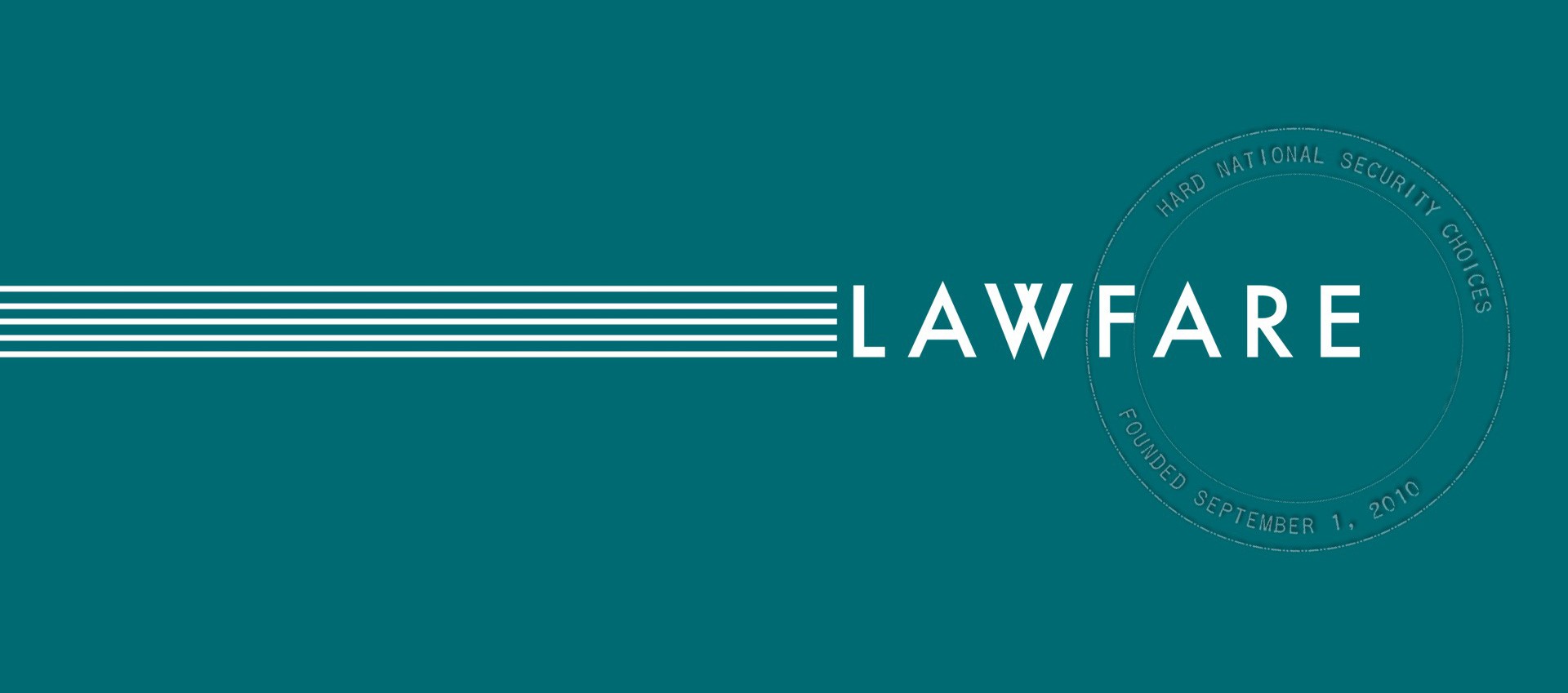Trying (and Failing) to Put Kaiser Wilhelm II on Trial
A review of William A. Schabas, “The Trial of the Kaiser” (Oxford University Press, 2018)
***
Published by The Lawfare Institute
in Cooperation With

A review of William A. Schabas, “The Trial of the Kaiser” (Oxford University Press, 2018)
***
It was a getaway to be made in style. On armistice eve, at last resigned to Germany’s defeat in World War I, Kaiser Wilhelm II fled his headquarters in Belgium on a blue-and-gold imperial train. In search of refuge, he was Netherlands bound, courtiers and imperial trappings in tow. The pomp and circumstance did not last the journey, however. A few kilometers on, fear of mutinous troops spooked the kaiser into relocating to an unmarked automobile. He made it to neutral Dutch soil before the war’s victorious powers were able to find and detain him, or before his own troops got him. But how long could he hope to stay safely in the Netherlands, with the Allies demanding that he be turned over to them? Wilhelm II was to appear as defendant, the Allies hoped, in the world’s first international trial of a head of state.
The Allies’ attempt to fulfill their vision and the kaiser’s luck in avoiding it are the story of “The Trial of the Kaiser,” by William A. Schabas, a well-known and highly regarded professor of international law at Middlesex University and Leiden University. Published during the attempted trial’s ongoing centennial, the book offers a comprehensive account of its political and legal history. It is skillfully researched, commanding a range of sources that makes possible the telling of what amounts to a global tale of international politics and law. This same research at times lingers over legal detail, but overall the book succeeds in telling the story in enough particulars to satisfy scholars, while still being accessible to a general reader.
The book is divided into three main parts. First, World War I’s victorious powers—Britain, France and Italy—agreed among themselves to put the kaiser on trial and set about laying the legal groundwork. Though the general idea had been present in broad political discourse during the war, it was raised in earnest in Allied circles at a meeting in Paris within two days of the armistice of November 11, 1918. Piggybacking on a report by two French law professors, Georges Clemenceau suggested the possibility to Lord George Curzon, Britain’s foreign secretary. Back in London, David Lloyd George—soon to dominate a general election on cries of “hang the kaiser”—eagerly agreed, as did the Italians. Only Woodrow Wilson wavered.
At the Paris Peace Conference, the Commission on Responsibilities was formed to explore the idea; it was chaired by Robert Lansing, America’s secretary of state. Although an eminent lawyer, the secretary was skeptical about the notion of war crimes. The sinking of RMS Lusitania in 1915 had outraged Americans. But Lansing was less stirred up. “He believes that almost any form of atrocity is permissible,” a contemporary wrote, “provided a nation’s safety is involved.” In this pre-U.N. Charter, pre-League of Nations, pre-Kellogg-Briand Pact era, it was (in Lansing’s seeming view) within a state’s sovereign prerogatives to decide when, why and against whom to wage war; and even if a state’s initiation of war was a violation of substantive international law, any remedy was essentially political, not juridical.
Even beyond Lansing’s (and his State Department’s) apparent view of the permissible legal scope of a state’s military necessity and a state’s sovereign right to decide when to resort to war, he additionally believed in the absolute sovereign immunity of heads of state as individual persons. In the context of the commission’s discussions, this had the effect of leaving the United States in opposition to an individual trial of the kaiser. Citing lack of precedent or procedure for an international tribunal to try the kaiser individually and criminally, the United States, through Lansing, refused to support one. The commission’s final report ultimately backed a tribunal, a recommendation from which the United States dissented.
The second part of “The Trial of the Kaiser” takes up the discussions and actions of the so-called Council of Four—Wilson, Clemenceau, Lloyd George and Prime Minister Vittorio Orlando of Italy—that followed the commission’s final report. Among these national leaders, all but Clemenceau had studied law, but this seems barely to have affected the legal quality of their discussions. They seem to have been unfamiliar with international law of their era. Seen from an international lawyer’s point of view, their talk descends into the irrelevant and the misinformed. Any legal expert from the commission, Schabas says, would have been appalled if present.
In these discussions among political leaders, however, Wilson—chronically ill and estranged on other grounds from his own secretary of state—yielded to his fellow Allied leaders. He agreed to a tribunal, but with a catch: The charges must be “political,” not “criminal.” The kaiser was to be tried, not for breaking (criminal) laws but, instead, for “a supreme offense against international morality and the sanctity of treaties.” Whatever exactly this was intended to mean, politically or legally, it served as the basis for Article 227 of the eventual Treaty of Versailles.
The third part of “The Trial of the Kaiser” turns to a quite different issue than the legal and political path to a tribunal; it examines attempts—both formal and informal—to detain the kaiser in anticipation of a trial before some form of international tribunal. As to the informal, in January 1919, Luke Lea, a U.S. senator from Tennessee turned U.S. Army colonel, decided on his own authority to capture the kaiser and make a gift of him to Wilson in Paris. Posted in Luxembourg, Lea recruited a posse of soldiers with whom he secretly headed to the kaiser’s castle in the Netherlands. While they succeeded in entering his residence, they wound up leaving when the kaiser refused to see them.
As to the formal attempts, the Allies agreed early on among themselves to ask the Dutch to extradite the kaiser. With the kaiser’s fate in question, however, European monarchs schemed to protect a fellow royal. The kings of Italy, Spain and Sweden all campaigned for Wilhelm. The Pope joined the chorus, arguing that it would be best to put the wartime past behind. German princes wrote to King George V, offering to substitute themselves for the kaiser. The British King—Wilhelm’s cousin—responded to such entreaties by pointing to the British crown’s constitutional helplessness.
To what end? Though the Allies had agreed to seek the kaiser’s extradition, they didn’t deliver their formal legal demand to the Dutch until implementation of the Versailles treaty began—over a year after the 1918 armistice. By then it was politically too late. Enthusiasm for a trial had waned. It had also become clear that America would refuse to ratify the treaty (the U.S. Senate withheld its consent in a vote in 1919) with political consequences for important provisions of the agreement, including Article 227. The Dutch, for their part, refused to hand over the kaiser. Theirs is a “land of refuge,” they explained, and in their eyes the kaiser was a refugee. In any case, the Allies had done little to prepare a case for trial. Schabas says this may have been because they thought the outcome was certain—or because they foresaw the Dutch reply.
What can we make of this colorful political and legal history today? Is the kaiser’s abortive trial merely a dead evolutionary branch in the history of international law—or does it still matter? It is hard to imagine now, but the mere idea of a trial in an international court was revolutionary then. The English beheaded Mary, Queen of Scots, in 1587, but her trial took place before an English court. The Napoleonic Wars, though fought under the flags of multinational coalitions, never inspired the thought. Calls to try Napoleon had French courts in mind. After the Franco-Prussian War, Otto von Bismarck thought about trying Napoleon III before foreign judges. But the idea was fleeting.
The nearest precedent, such as it was, took place much earlier. In 1474 Peter von Hagenbach, a Burgundian mercenary knight, faced trial for his atrocities in Alsace and was put to the sword by judges from states of the Holy Roman Empire. Only after World War I did the idea of an international war-crimes trial really awaken from this long sleep.
Though Kaiser Wilhelm died at his manor in the Netherlands aged 82 in 1941, the failed trial that once threatened his life or at least his liberty outlives him still, at least in Schabas’s view. His most striking claim about the attempted trial of the kaiser is that it is “central” to the origins of modern international criminal justice. He similarly argues that the “real start” of the debate on the prohibition of aggression was at the Paris Peace Conference—rather than through the Kellogg-Briand Pact, as Oona Hathaway and Scott Shapiro argue in “The Internationalists: How a Radical Plan to Outlaw War Remade the World” (reviewed on Lawfare by Michael Glennon).
Paris also marked the first time, according to Schabas, that governments—their diplomats, lawyers and political leaders—entertained “real consideration of an international criminal court.” My own sense is that America’s stance in response to this idea played a role in—perhaps even inaugurated—this country’s lasting, though unsettled, sentiment against global tribunals. In any case, thanks to this trial, Schabas says, the debate about guilt by abstention began “in the sessions of the Commission on Responsibilities.” And the commission created the first list of named war crimes, to the benefit of experts in London decades later who used it as a point of departure in prosecuting Nazis. It “was invoked as authority” in postwar trials and made its way into the national legislation of some states and eventually into provisions of the Statute of the International Criminal Court.
Even in the absence of a trial, there was also a form of punishment—de facto rather de jure. Wanted by the world, Kaiser Wilhelm spent the rest of his life under house arrest, the Dutch government charged with his custody. The threat of trial itself was enough to bring about a measure of punishment—without making him a martyr and without purporting to shift the guilt of a country onto one man. “No greater or more enduring punishment would, or could, have been imposed,” Lloyd George reassured a member of Parliament who was upset about the trial’s supposed failure. To be sure, in this the prime minister was not wholly correct. The treaty and its famous Article 227 never provided a penalty, leaving that to the judges. Yet Lloyd George pointed out a larger truth. The kaiser ended as a captive, doing time on a penal island of his own.




